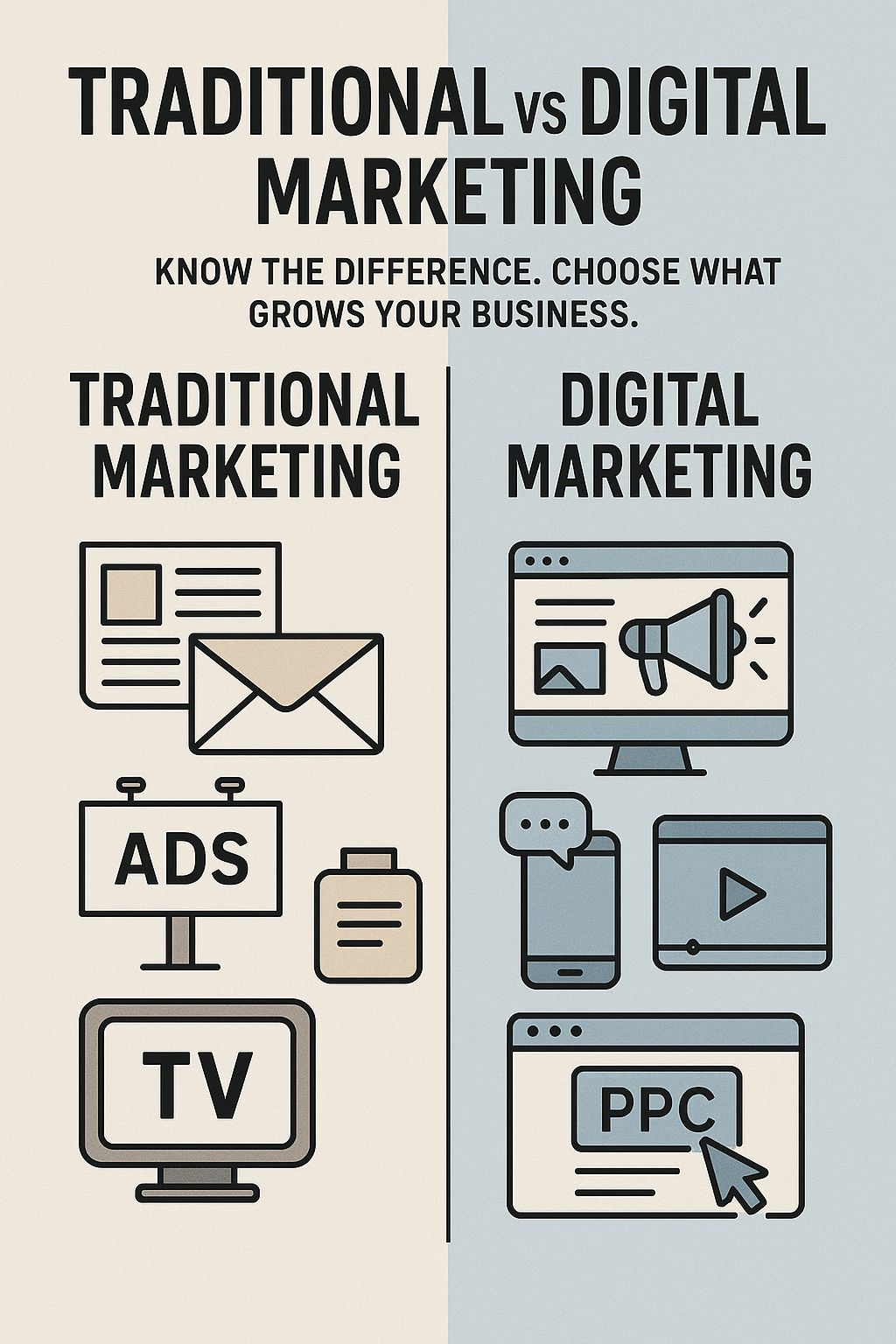Difference Between Traditional Marketing and Digital Marketing in 2025
Marketing has evolved rapidly, and by 2025, businesses rely heavily on digital strategies to grow faster, reach wider audiences, and track performance in real time. Still, both traditional and digital marketing have unique roles. Here’s the comparison:
1. Platform of Promotion
Traditional Marketing
-
Uses offline channels
-
Examples: TV ads, radio, newspapers, magazines, billboards, posters, pamphlets
-
Limited reach to a specific geographic location
Digital Marketing
-
Uses online platforms
-
Examples: Google, YouTube, Facebook, Instagram, WhatsApp, LinkedIn, websites, email
-
International reach with no location limit
2. Targeting Capability
Traditional
-
Very broad, less specific targeting
-
Targets mass audiences without personalization
-
Limited control on who sees your ad
Digital
-
Highly targeted ads
-
Filter by: age, gender, interest, location, behavior, device
-
Personalized marketing for every customer segment
3. Cost & Budget Requirements
Traditional
-
High cost (TV, newspapers, hoardings are expensive)
-
Not affordable for small businesses
-
Fixed pricing with limited flexibility
Digital
-
Low to medium budget options
-
Suitable for small, medium, and large businesses
-
Flexible: you can start with even ₹200 per day
-
High ROI due to performance tracking
4. Speed of Execution
Traditional
-
Slow process (printing, approvals, media buying)
-
Takes days or weeks to execute
Digital
-
Instant execution
-
You can launch ads within minutes
-
Faster optimization and real-time changes
5. Audience Engagement
Traditional
-
One-way communication
-
Customers cannot interact with the ad
-
No instant feedback
Digital
-
Two-way communication
-
Likes, comments, shares, messages, reviews
-
Higher engagement leads to better branding
6. Measurability & Analytics
Traditional
-
Difficult to measure
-
No proper data on reach, leads, or conversions
-
Guess-based marketing
Digital
-
100% measurable
-
Track clicks, reach, impressions, leads, conversions
-
Data-driven decision-making
7. Flexibility & Optimization
Traditional
-
Once posted or printed → cannot change
-
Bad ad = waste of money
Digital
-
Can change campaigns anytime
-
Pause, edit, and optimize campaigns in real time
-
A/B testing for better results
8. Customer Reach
Traditional
-
Local reach
-
Good for regional promotion
Digital
-
Local + national + global reach
-
Suitable for brands wanting rapid growth
9. Content Types Used
Traditional
-
Print ads
-
Audio & video ads
-
Billboards, banners, brochures
Digital
-
Videos, reels, stories
-
Blogs, SEO content
-
Graphics, animations
-
Emails, WhatsApp broadcasts
10. Suitability in 2025
Traditional Marketing Is Best For:
-
Elderly audience
-
Local brands focusing on nearby customers
-
Events, exhibitions, hoardings
Digital Marketing Is Best For:
-
Startups, businesses, hospitals, showrooms, e-commerce
-
National or global reach
-
Performance-driven results
Conclusion
In 2025, digital marketing is the most powerful, cost-effective, and result-oriented method for growing any business.
Traditional marketing still has value, but digital marketing offers speed, targeting, scalability, and measurable ROI, making it the preferred choice for most industries today.


